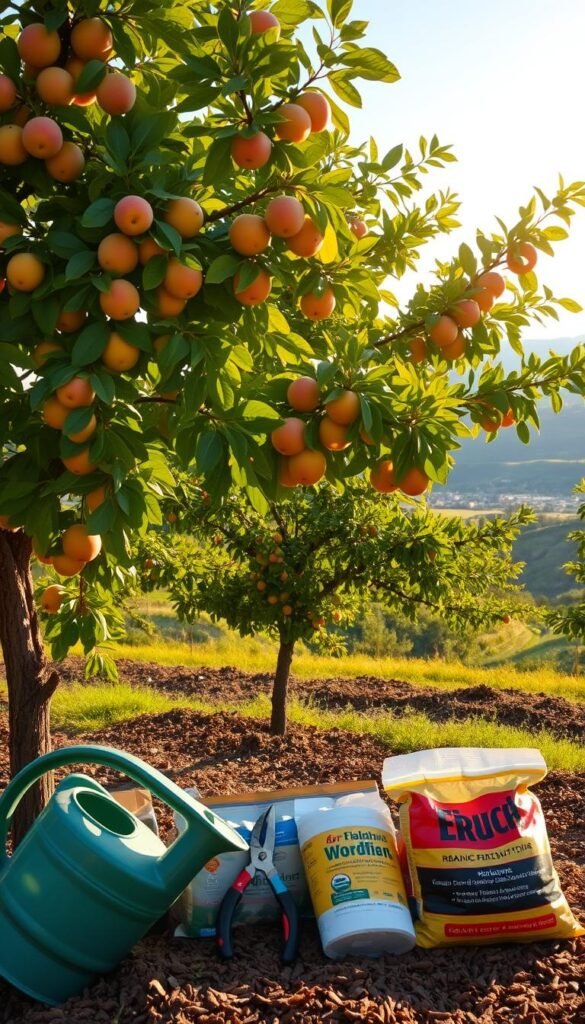Creating a thriving outdoor space with productive trees starts with three key elements: smart nutrition, soil protection, and proactive care. These components work together to build strong, resilient plants that reward you season after season.
Balanced nourishment is critical for development. Nitrogen, phosphorus, and potassium each play unique roles in supporting growth cycles and flower production. Timing matters—applying nutrients in early spring gives trees energy as they exit dormancy. For organic options, compost or fish-based blends provide gentle feeding without overwhelming delicate root systems.
Healthy soil acts like a savings account for your greenery. Protective ground covers lock in moisture while regulating temperature fluctuations. This creates ideal conditions for roots to absorb minerals efficiently, directly impacting how many blossoms—and eventually treats—your specimens produce.
Stay ahead of challenges by observing your trees’ language. Yellowing leaves or stunted growth often signal needs. A consistent care routine combining properly timed nourishment with attentive monitoring helps prevent issues before they escalate. When these practices align, you’ll see the difference in every bud and branch.
Preparing Your Garden for Fruit Plants
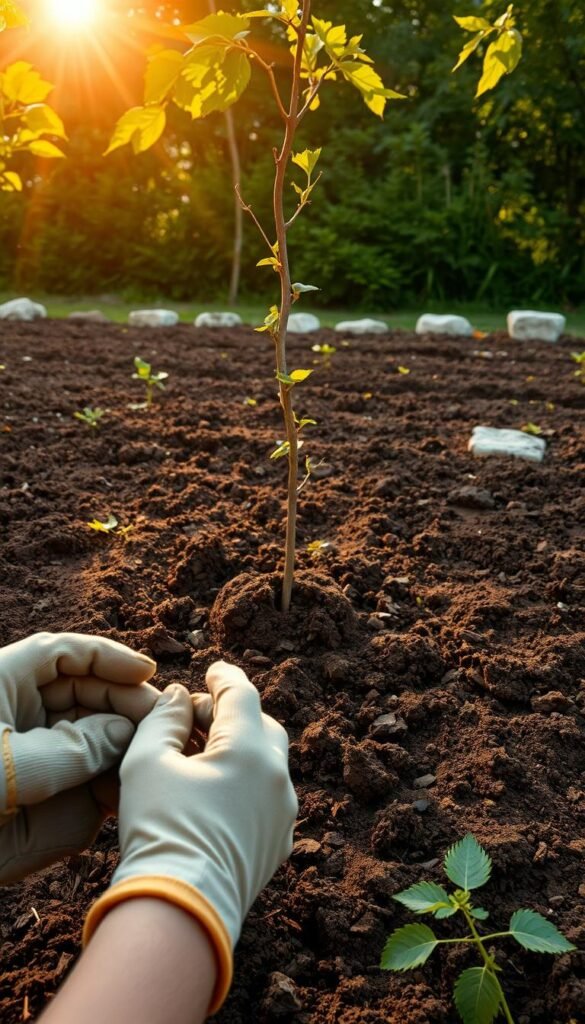
Your journey to delicious homegrown treats begins with smart groundwork. Two critical steps separate struggle from success: matching plants to your environment and building living soil that breathes life into every root.
Climate-Smart Variety Selection
Not all trees thrive everywhere. Peaches might bake in Arizona’s heat, while cherries shiver through Florida winters. Check your USDA hardiness zone first—this number reveals which varieties survive your coldest months. Local nurseries often stock winners for your area. As one orchardist notes:
“A tree that belongs will outproduce a trendy pick every time.”
Building Fertile Foundations
Dig deeper than surface-level dirt care. Grab a soil test kit ($15 at garden centers) to uncover hidden needs. Ideal earth crumbles like chocolate cake—45% minerals, 5% organic matter, 25% water, and 25% air. Mix in 3 inches of compost before planting to boost nutrients. For clay soils, add sand; sandy spots get peat moss. This prep work helps roots spread wide, anchoring trees against storms and droughts.
Remember: Well-chosen varieties + thriving soil = fewer headaches later. Spend time here, and you’ll taste the difference in every juicy harvest.
Fruit Plants Garden Essentials: Fertilizers, Mulch, and Pest Control Tactics
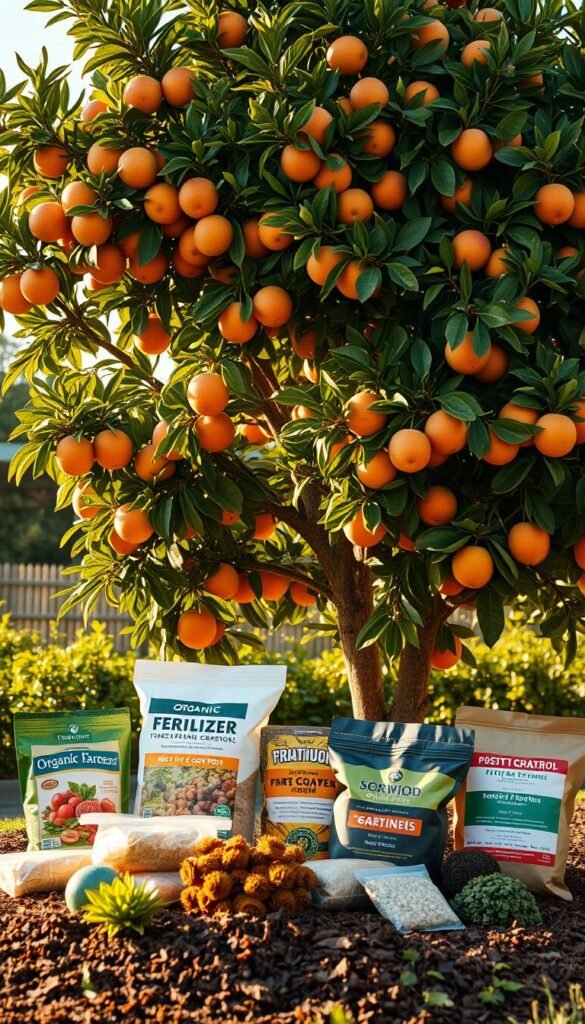
Growing vibrant, productive specimens requires balancing three pillars: nourishment, protection, and prevention. These strategies form a self-reinforcing cycle that boosts resilience while minimizing problems.
Smart Feeding Foundations
Your trees need regular meals tailored to their life stage. Organic options like blood meal or soybean meal deliver nitrogen gradually. Compost doubles as a nutrient booster and soil conditioner, offering trace minerals. Test your soil annually to catch deficiencies early—weak branches often signal calcium shortages.
| Organic Option | Nitrogen Content | Best For |
|---|---|---|
| Feather Meal | 12% | Slow-release feeding |
| Cottonseed Meal | 6% | Acid-loving varieties |
| Chicken Manure | 3% | Quick nutrient boosts |
Protection Through Partnership
Ground covers do more than conserve moisture—they suppress weeds that compete for nutrients. A 3-inch layer of wood chips regulates soil temperature, encouraging roots to spread. This stability helps trees absorb minerals efficiently during growth spurts.
Watch for curled leaves or early fruit drop—these often hint at pest pressures. As horticulturist Linda Chalker-Scott advises:
“Healthy specimens outgrow minor infestations. Focus on building vigor first.”
Pair quarterly feedings with monthly inspections. Adjust your approach based on bud development and leaf color. This responsive care keeps trees thriving through seasons.
Mastering Fertilization for Lush Fruit Tree Growth
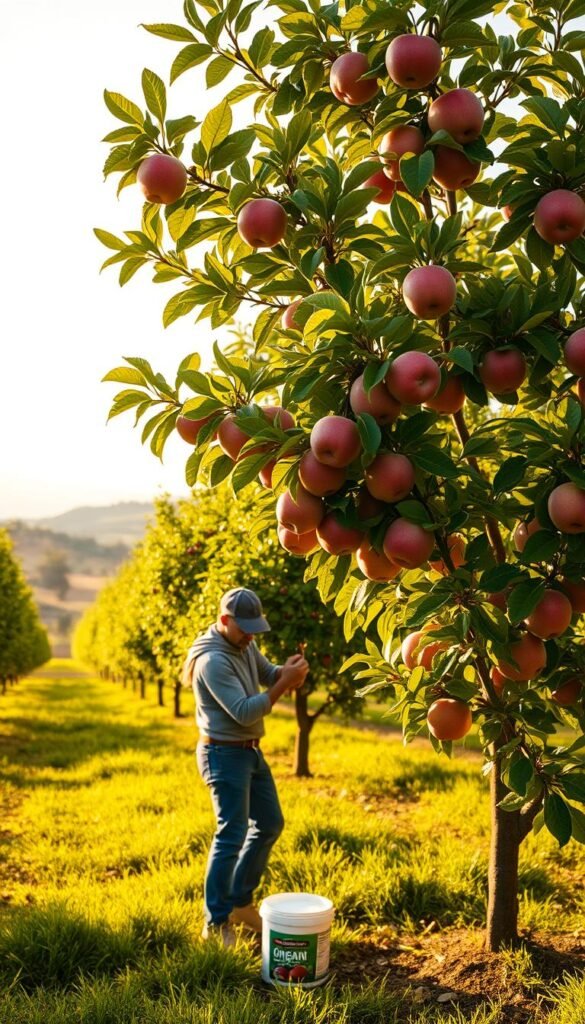
Timing and precision separate decent harvests from extraordinary yields. Let’s explore how to match your feeding strategy to your trees’ natural rhythms for maximum results.
Sync With Nature’s Schedule
Apply your first round as buds swell in early spring—this fuels new shoots without forcing premature growth. Continue light feedings until July, then stop nitrogen completely. Late-season nutrients push tender growth that frosts can damage.
Check if feeding is needed by measuring last year’s branch extensions. Young peaches should add 18-24″, while mature apples need just 6-10″. No growth? Skip fertilizing that year.
Math Meets Horticulture
Use this formula: Tree age (years) × 0.10 = pounds of actual nitrogen needed. For a 5-year-old specimen with 4″ trunk diameter:
| Fertilizer Type | Nitrogen % | Pounds Needed |
|---|---|---|
| E.B. Stone 7-5-2 | 7% | 1.4 lbs |
| Jobe’s Organic 3-5-5 | 3% | 3.3 lbs |
| Espoma 9-3-3 | 9% | 1.1 lbs |
Spread granules from 12″ past the trunk to the drip line. Water deeply afterward. As arborist Michael Phillips notes:
“Trees remember how they’re fed. Consistent, measured meals build resilient producers.”
Watch for dark green leaves and steady growth—these signal your plan works. Adjust amounts yearly based on branch length and fruit set.
Mulching and Pest Control Strategies for a Thriving Garden
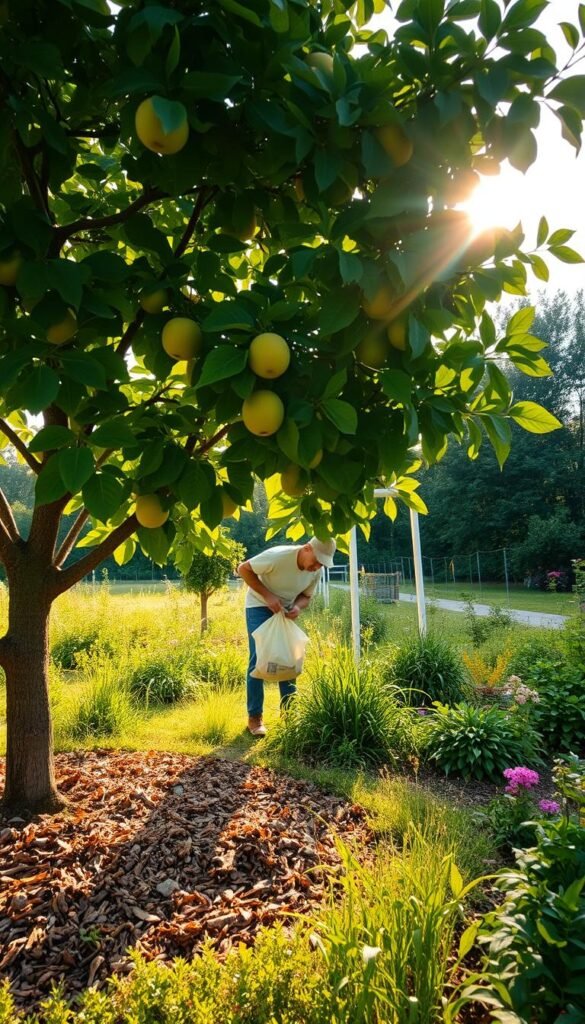
Protecting your orchard’s foundation while managing unwanted visitors creates the perfect environment for abundant harvests. These twin strategies work together to maintain vigorous growth and minimize stress on your plants.
Benefits of Mulching: Moisture Retention and Temperature Regulation
A 3-inch layer of organic material acts like a thermostat for root systems. It keeps soil consistently moist during dry spells and prevents rapid temperature swings. This stability helps trees absorb nutrients efficiently, especially during critical growth phases.
Choose materials that break down gradually to feed your soil. Wood chips and straw improve earth structure as they decompose, while stone mulches work better in fire-prone areas. Always leave a 6-inch gap around trunks to prevent rot.
| Mulch Type | Decomposition Rate | Best Use |
|---|---|---|
| Hardwood Chips | 2-3 years | Established orchards |
| Pine Straw | 1 season | Acidic soil lovers |
| Crushed Leaves | 6 months | Quick nutrient boost |
Integrated Pest Management to Keep Your Trees Healthy
Spotting trouble early makes solutions easier. Check leaves weekly for unusual spots or chew marks. Sticky traps help monitor flying insects without chemicals.
Invite nature’s helpers by planting nectar-rich flowers near your orchard. Ladybugs devour aphids, while lacewings tackle mealybugs. As entomologist Doug Tallamy advises:
“Diverse plantings create balanced ecosystems where pests rarely dominate.”
For active infestations, try these organic solutions:
- Neem oil sprays disrupt insect life cycles
- Diatomaceous earth controls crawling pests
- Copper fungicides prevent common diseases
Combine these approaches with proper pruning and cleanup. Healthy trees naturally resist most threats, letting you enjoy sweeter rewards with less work.
Wrapping Up Your Fruit Garden How-To Guide
Your care routine becomes a cycle of rewards when aligned with nature’s rhythms. Early spring nourishment at bud break fuels blossoms without overwhelming growth, while regular soil tests keep pH and minerals balanced. This timing lets roots absorb what they need most during active phases.
Think of your strategies as interconnected practices. Ground covers conserve moisture while suppressing competitors. Beneficial insects patrol leaves when you provide habitat diversity. Each choice builds soil vitality, creating stronger specimens year after year.
Trust your observations—pale leaves or slowed branch extension often reveal needs. Adjust your approach using simple tools: organic blends for gentle feeding, compost for trace elements, and targeted solutions for occasional pests. Remember, consistent care beats heroic efforts every time.
The groundwork you’ve done—selecting climate-suited varieties and enriching earth—pays dividends for decades. Young trees establish strong roots faster, while mature ones weather storms and droughts. With this foundation, you’ll spend less time fixing problems and more enjoying sun-ripened rewards.

